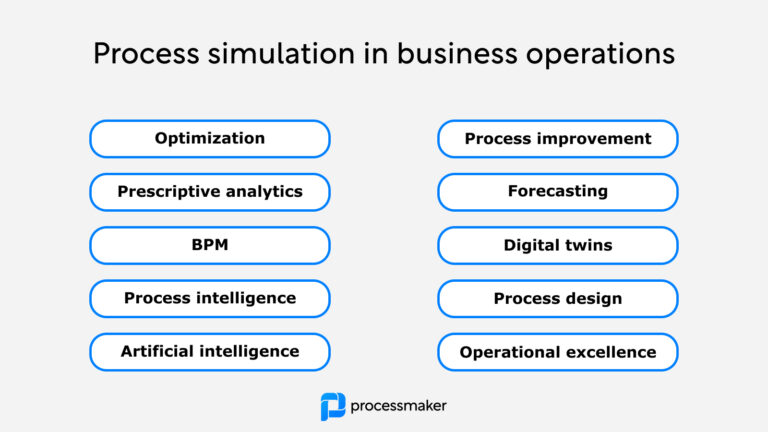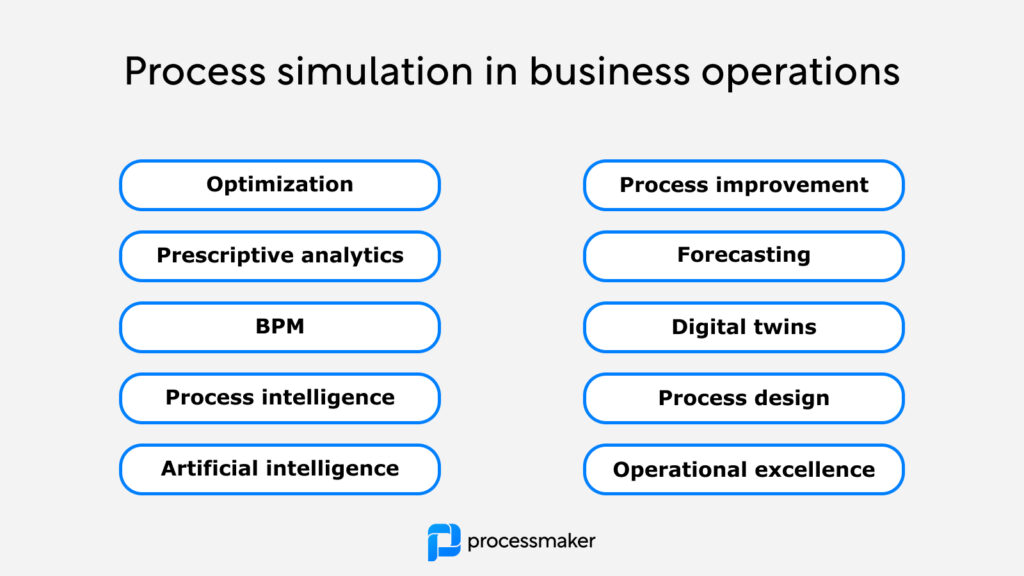

Process simulation is an increasingly popular area in business process management and advanced process intelligence. In this article, we review key definitions, examples, and best practices every operations leader needs to know.

Process simulation in business operations
Process simulation is a method of analyzing and improving business processes using computer-based forecasting models. Process simulation allows businesses to explore “what if” scenarios, analyze the impact of changes to processes, and identify opportunities for improvement.
The goal of process simulation in business operations is to achieve a higher level of process efficiency, which ultimately leads to increased profitability and competitive advantage.
Process simulation is a powerful tool in process optimization because it is able to imitate different scenarios without disrupting existing operations. By creating a digital twin of a process, the simulation can be used to iterate and improve processes and adjust them to see what works best. This allows businesses to identify potential problems and opportunities for improvement before implementing them in the real world.
Process simulation helps identify areas of improvement in an organization’s processes. Moreover, it can be used to develop better strategies for advancing process excellence.
Process simulation can also be used to identify potential risks associated with new initiatives and to optimize existing operations as part of a process analysis project. By taking the time to analyze and simulate processes thoroughly, businesses can make better decisions and improve profitability.
Process simulation typically involves the following six steps:
Process simulation software uses computer algorithms and data science to create a digital model of a business process. Following that, it can forecast how the digital model would react in different kinds of process scenarios.
Visualization of a simulation and model. Source: Danski14 / wikipedia
By simulating different scenarios, businesses can identify bottlenecks in their processes and make changes to reduce them. This can be used to train employees on how to best use existing systems or to re-engineer new processes.
Additionally, process simulation can be used to create a digital process twin of an organization (DTO) that mimics an entire business organization in the real world.
There are several popular process simulation tools available that cater to different industries and use cases. Some of these tools are specialized for business process management, while others are more general-purpose simulation tools that can be adapted for process simulation. Here is a list of some popular process simulation tools:
1. What is a process simulation?
Process simulation is a technique used to model, analyze, and visualize the flow of business processes in a virtual environment. It allows organizations to evaluate the efficiency and effectiveness of their existing processes, identify bottlenecks and areas for improvement, and test the impact of proposed changes before implementing them in the real world. By simulating different scenarios and observing their outcomes, businesses can make data-driven decisions to optimize their operations and achieve better results.
2. Can process simulation be done in Python?
Yes, process simulation can be done in Python using various libraries and tools. Python offers a number of libraries, such as SimPy, DEAP, and SALib, which can be used to create discrete event simulations, agent-based models, and other types of process simulations. These libraries allow users to define custom models, simulate different scenarios, and analyze the results to inform decision-making and optimize business processes.
3. What is an example of process simulation?
An example of process simulation could be a manufacturing company analyzing its production line to identify inefficiencies and optimize throughput. First, the company would create a model of the production process, including all tasks, resources, and decision points. They would then run simulations with different scenarios, such as varying resource allocations or changing the sequence of tasks, to identify bottlenecks and areas for improvement. Based on the simulation results, the company could make informed decisions to modify the production process and ultimately increase efficiency and productivity.
4. What is the goal of process simulation?
The goal of process simulation is to help businesses evaluate the performance of their current processes, identify inefficiencies and bottlenecks, and test the impact of proposed changes before implementing them in the real world. By simulating various scenarios and analyzing their outcomes, businesses can make data-driven decisions to optimize their processes, reduce costs, minimize risks, and improve overall efficiency. Process simulation allows organizations to experiment with different scenarios in a controlled environment and implement changes with greater confidence and understanding of their potential impacts.